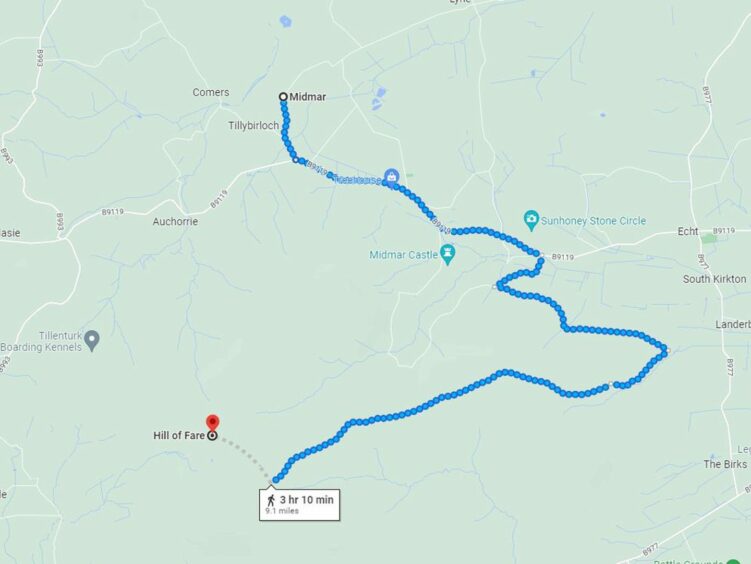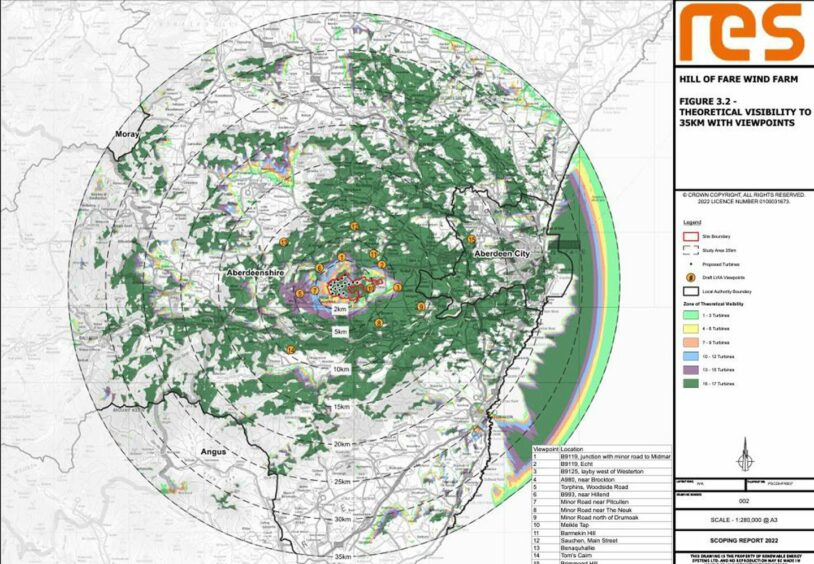
An Aberdeenshire resident that has stayed in the same home for 40 years has written a letter of complaint to those behind a local wind farm proposal.
Company RES’s proposed wind farm would be made up of 17 turbines, 820ft tall situated on the Hill of Fare, less than four miles from Banchory in Aberdeenshire.
Frank Murray of Midmar, north of Banchory, has written a letter documenting his objections to the scheme to its project manager Gavin Shirley.
He described his home as “an idyllic place to live”, however, his south-facing land would look on to RES’ proposed wind farm.
Mr Murray has enjoyed the “peace and tranquillity of the surrounding countryside” since his home was built in 1982 but is now worried that this will be ruined if the project comes to fruition.
He said he is not opposed directly to the wind turbines, citing the four that are visible from his home, but his concern lies with the impact it may have on the community and wildlife in the area.
The letter has also been sent to the chairman of Cluny, Midmar and Moneymusk Community Council, Aberdeenshire Councillors, National Trust for Scotland, Members of the Scottish Parliament, Members of Parliament and local press.
Impact on residents from Aberdeenshire turbines
The Aberdeenshire resident expressed concern around the impact of the so-called “Stroboscopic Light Flicker Effect”.
This is the term given to the visual phenomenon which comes as a result of continuous rotational motion.
Citing videos online of homes near turbines in Cwmfelin Boeth (Wales), Wisconsin (USA) and even Stonehaven (Aberdeenshire) are impacted by this phenomenon.
In the video above a Cwmfelin Boeth resident documents the effects of the stroboscopic light flicker effect, explaining that shortly after her home started experiencing this she began to feel pain in her eyes that progressed into a headache.
Mr Murray expresses his concern, writing: “These effects would seriously reduce the attractiveness of living and working in this area and will certainly adversely affect the monetary value of existing and future homes.”
The Midmar resident also expressed concern about noise pollution in his letter.
Towering over Aberdeenshire
The 820ft turbines are set to stand on the Hill of Fare which already stands at 1,545ft.
Mr Murray pointed out that the combined height of the proposed turbines and the hill they will stand on measures 2365 ft.
This is taller than the largest mountain in the Aberdeenshire area, Bennachie, which stands at 1,732ft, and “can be seen throughout much of the county.”
This is supported by the project’s planning documents which show the turbines are “theoretically visible” with viewpoints from 20 miles away in all directions; from Moray to Angus.
It is worth noting that these are not the tallest turbines proposed to stand in Scotland, Dunside wind farm (currently under pre-application) in the borders will have 853 ft turbines if approved.
In defence of their proposed turbine heights, RES said: “Turbine technology has continued to advance considerably and new onshore wind projects like the proposed Hill of Fare Wind Farm are amongst the lowest cost forms of generating electricity.
“These modern, taller turbines generate significantly more electricity which will help to address the climate emergency, cost of living crisis and security of energy supply issues that we currently face.”
Additionally, according to RES, it will produce enough electricity to power 90,000 homes and create a reduction in carbon emissions of approximately 142,000 tonnes each year.
Historical significance
Mr Murray also pointed to the historical significance of the Hill of Fare, citing the 1562 Battle of Corrichie, fought between the forces of Mary Queen of Scots and
those of the 4th Earl of Huntley George Gordon.
The battle, from Murray’s perspective, was greatly impactful to the geopolitics at the time, as it “greatly reduced Gordon’s influence in Scotland” and solidified Queen Mary’s power in Scotland.

 © Supplied by Google maps
© Supplied by Google maps © Supplied by RES
© Supplied by RES